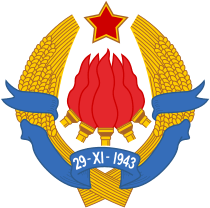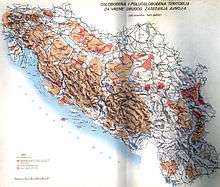Anti-Fascist Council for the National Liberation of Yugoslavia
The Anti-Fascist Council for the National Liberation of Yugoslavia, known more commonly by its Yugoslav abbreviation AVNOJ (Serbo-Croatian: Antifašističko vijeće narodnog oslobođenja Jugoslavije – AVNOJ / Антифашистичко веће народног ослобођења Југославије – АВНОЈ[lower-alpha 1]), was the political umbrella organization for the national liberation councils of the Yugoslav resistance against the Axis occupation during World War II. It eventually became the Yugoslav provisional wartime deliberative body. It was established on November 26, 1942, to administer territories under the control of the Partisans.

First session of the AVNOJ


After the Yugoslavian army capitulated on April 17, 1941, Yugoslavia was distributed between Germany, Italy, Bulgaria, Hungary and the newly formed puppet states: the Independent State of Croatia, the Italian governorate of Montenegro, Greater Albania and Nedić's Serbia. Opposition to these occupation regimes caused the formation of resistance movements, resulting in the Communist Party of Yugoslavia (KPJ), then only active in the underground but fast gaining popularity, assuming the role of leading the forces in the Yugoslavian resistance. The KPJ as an organisation comprised people from, and drew support from, the whole of Yugoslavia; as such, it represented a single Yugoslav identity.
On November 26, 1942, the Partisan leaders of Yugoslavia convened the first AVNOJ meeting at Bihać, in a liberated pocket called the Bihać Republic in the northwest of Bosnia, in the hope of gaining political legitimacy. The Slovene delegation could not attend due to intense fighting, but it fully approved the federal build-up of the new Yugoslavia.[1] Comprising a committee of both the communist and non-communist Partisan representatives, under Josip Broz Tito, AVNOJ proclaimed support for:
- democracy;
- the rights of ethnic minorities;
- the inviolability of private property; and
- freedom of individual economic initiative for the different groups.
In January 1943, Germany mounted a fourth large-scale anti-partisan offensive to strengthen its control of Yugoslavia by destroying the central command of the Partisan movement – the Central Committee of the KPJ – and the primary Partisan hospital. The Partisans, outnumbered and engaged in major battles with the Chetnik formations of Colonel Draža Mihajlović, Ustasha militias and the combined German and Italian regular forces, were steadily forced into retreat until an elaborate deception plan allowed the Partisans to escape their pursuers. Despite the tactical defeat and the loss of men and equipment, the Partisan central command remained intact and the hospital safe which, over time, enabled the continuation of further operations against the enemy. All the major strategic military offensives of the Axis and their collaborators were ultimately thwarted.
In May of the same year, German, Italian, Bulgarian and Croatian troops launched a fifth concerted offensive against the Partisans in south eastern Bosnia, near the Sutjeska river. Again, faced by superior enemy numbers and potential encirclement, the Partisans escaped defeat but not without cost. However, the fact that after their successful breakout the Partisans were still able to mount major counter offensives proved to be a turning point in the battle for control of Yugoslavia. When Italy surrendered in September, the Partisans were further aided by captured Italian armour, control of additional coastal territory, and the shipment of supplies from the Allies in Italy.
Second session of the AVNOJ

"We are convinced that our Allies will not misunderstand this historic step taken by our people, but rather that they will do everything to give our people their moral and material help and backing, and this through the representatives elected by the people themselves in their own country."[2]



In its second conference in the Bosnian town of Jajce, from November 29 to November 30, 1943, Tito declared the Anti-Fascist Council for the National Liberation of Yugoslavia to be the superior executive authority in the country. The decisions and the resolutions of the second AVNOJ conference were:
- to create a federal Yugoslavia, based on the right of self-determination of nations, in which the southern Slavic peoples (Serbs, Croats, Macedonians, Muslims, Slovenes, and Montenegrins) who would live in six constituent republics with equal rights;
- to stress that even during the War of National Liberation there had been established anti-fascist councils of the national liberation of Yugoslav lands for Serbia, Croatia, Slovenia, Bosnia and Herzegovina, Sandžak, Macedonia, and Montenegro and the Bay of Kotor as the organisations of the people's administration of the land;
- to elect the National Committee for the Liberation of Yugoslavia (Nacionalni komitet oslobođenja Jugoslavije/Национални комитет ослобођен ја Југославије; NKOJ/НКОЈ), based in Jajce, to act as the temporary government;
- to name Tito, Marshal of Yugoslavia and Prime Minister;
- to revoke the Yugoslavian government-in-exile; and
- to deny King Petar II Karađorđević’s return to the country, until a popular referendum had been held on the status of the monarchy.
To counter decisions of AVNOJ to organize Yugoslavia as federative republic, Draža Mihailović organized a Saint Sava Congress participated by representatives of former liberal political parties from Serbia, Montenegro and Slovenia together with some pro-Yugoslav politicioans from Croatia, based on the idea of Yugoslavia as tripartite constitutional monarchy headed by Serb souvereign.[3]
In December 1943, Roosevelt, Churchill, and Stalin decided to support the Partisans. The United Kingdom joined a month later, and stopped supplying the Chetniks. The first Soviet mission arrived at Partisan headquarters, shortly thereafter. The United States kept a military mission with Mihajlović to encourage continued Chetnik aid for downed American fliers.
In May 1944, German airborne forces attacked Tito's headquarters in Drvar, nearly capturing him. Tito fled to Italy, and established a new headquarters on the Adriatic island of Vis. After throwing its full support to the Partisans, Britain worked to reconcile Tito and Petar. At Britain's urging, Petar agreed to remain outside Yugoslavia, and in September, summoned all Yugoslavs to back the Partisans.
Resolutions from November 1944
The formulation of the resolutions at Jajce were revised and affirmed on 21 November 1944 in Belgrade, the city had been taken on 20 October by the Red Army and the Partisans under the leadership of Josip Broz Tito. One of the resolutions dealt with: "the decree about the transition of hostile goods to be turned into state property; about the public administration of the property of absent persons and seizure of the property alienated by force from the occupying powers“. After this all possessions of the German Reich and its citizens, on the territory of Yugoslavia “ as well as all possessions of persons of German nationality, except those Germans who fought as members of the national liberation army and the partisan units of Yugoslavia or who are citizens of neutral states, who did not behave hostilely during the Occupation “, should become the property of the new Yugoslav state. Besides this all possessions of the war criminals and their accomplices without consideration for their nationality and the fortune of each person, who was condemned, is seized by judgment of the civilian or military courts to become the possession of the state “.
New laws starting in 1945
On 6 February 1945, the decree of 21 November 1944 was transferred to the legislation of the Republic of Yugoslavia and incorporated into the Confiscation Law of 9 June 1945 and also into the law for agrarian reform of 23 August 1945. The law dealing with the voting lists of 10 August 1945 specified that "members of the military formations of the Occupiers and their native accomplices, and those who continuously and actively fought against the Liberation Army of Yugoslavia and/or against the Royal Yugoslav Army or against the armies of the confederates of Yugoslavia" are all denied the active right to vote. Moreover, the existence of these resolutions are confirmed in the establishment status of the autonomous area Vojvodina, which was created by decree of the presidency of the Serbian representative government (Službeni glas NIC Srbije of 9 September 1945) where a guarantee was made in article 4 "to all nationalities the full equal rights as a citizen of Serbia with exception of the German nationality, that due to the decision of the AVNOJ of 21 November 1944 the civic rights (državljanska prava) were taken away." The AVNOJ resolutions became law on 1 December 1945 explains Leon Geršković and E. Zellweger.[4][5] As a result, the flight and expulsion of the Danube Swabians (1944–48) began as part of the flight and expulsion of Germans (1944–50) and more than 170,000 Yugoslavian Danube Swabians were declared to be Germans and deported into many labor and concentration camps in Yugoslavia .
See also
Notes
- In the languages of Socialist Federal Republic of Yugoslavia, the names were:
- Serbo-Croatian: Антифашистичко веће народног ослобођења Југославије – АВНОЈ / Antifašističko veće narodnog oslobođenja Jugoslavije – AVNOJ, Ijekavian spelling: Antifašističko vijeće narodnog oslobođenja Jugoslavije – AVNOJ
- Macedonian: Антифашистичко собрание за народно ослободување на Југославија - AСНOJ / Antifashistichko sobranie za narodno osloboduvanje na Jugoslavija – ASNOJ
- Slovene: Antifašistični svet narodne osvoboditve Jugoslavije – ASNOJ
References
- Lukić, Reneo. Lynch, Allen (1996). "III. Nationalism and Federalism in Royalist and Communist Yugoslavia, 1929–54". Europe from the Balkans to the Urals. Oxford University Press. pp. 72–73. ISBN 978-0-19-829200-5.CS1 maint: uses authors parameter (link)
- Basil Davidson: PARTISAN PICTURE
- (Sirotković & Margetić 1988, p. 351): "Draža Mihailović, želeći brzo parirati odlukama AVNOJ-a, saziva predstavnike bivših građanskih stranaka iz Srbije, Crne Gore i Slovenije, pojedine jugonacionaliste iz Hrvatske te neke javne radnike na četnički kongres u selu Ba, pod padinama Suvobora. ... je proklamirana ideja ustavne i trijalističke monarhije (s prevlašću Srbije, dakako) kao protuteža proklamiranom federativnom uređenju u Jajcu."
- Leon Geršković : Historija narodne vlasti (history of people power), Belgrade 1957, S. 133 FF.
- E. Zellweger: Structure of state and legislation of the federal People's Republic of Yugoslavia 1945-1948 . In: Eastern Europe manual: Yugoslavia , S. 122 FF., see. the quotation of B. Kidrić, S. 129, and. ebda, S. 133, as well as the Belgrader Politika of 24 November 1944.
Sources
- Sirotković, Hodimir; Margetić, Lujo (1988). Povijest država i prava naroda SFR Jugoslavije. Školska knj. ISBN 978-86-03-99180-2.CS1 maint: ref=harv (link)
External links
| Wikimedia Commons has media related to AVNOJ. |